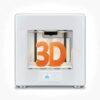3D Printing Elastomers Market Summary:
Elastomers are a type of polymer that can stretch and return to their original shape, making them ideal for applications that require flexibility and resilience. The 3D printing elastomers market is experiencing significant growth due to the increasing demand for flexible and durable materials in various industries. One of the key drivers of the 3D printing elastomers market is the growing adoption of additive manufacturing technology across different sectors. Industries such as automotive, aerospace, healthcare, and consumer goods are increasingly using 3D printing to create complex and customized products. Elastomers play a crucial role in these applications as they provide the necessary flexibility and elasticity. Moreover, the advancements in 3D printing technology have led to the development of new elastomers with improved properties. Manufacturers are now able to produce elastomers with varying degrees of hardness, flexibility, and chemical resistance, making them suitable for a wide range of applications. This has further fueled the demand for 3D printing elastomers in the market.
Additionally, the cost-effectiveness of 3D printing elastomers is another factor driving market growth. Traditional manufacturing methods often involve high tooling costs and long lead times. In contrast, 3D printing allows for rapid prototyping and on-demand production, reducing both time and cost. This has attracted small and medium-sized enterprises to adopt 3D printing technology, further boosting the demand for elastomers. The 3D printing elastomers market is witnessing significant growth due to the increasing adoption of additive manufacturing technology and the development of new elastomers with improved properties. The cost-effectiveness of 3D printing is also driving market growth. As industries continue to explore the potential of 3D printing, the demand for elastomers is expected to further increase in the coming years.
3D Printing Elastomers Market Overview:
The 3D Printing Elastomers Market overview provides a comprehensive understanding of the analyzed market. It includes an introduction to the market, its size, growth rate, and key trends. This aims to give clients a broad understanding of the market landscape. The market analysis of the 3D Printing Elastomers Market delves deeper into the market dynamics, focusing on factors such as market drivers, challenges, and opportunities. It explores the macroeconomic and microeconomic factors affecting the market, industry regulations, and emerging market trends. The analysis provides valuable insights into the current and future market conditions.
The assessment of the 3D Printing Elastomers Market is performed by taking various factors into consideration, like, for instance, the business expansion policies of key players, competitive analysis of the progress of new entrants and emerging players, and the revenue, financial, and opportunity analysis of market players. The also analyzed based on regional segmentation, type or technique, end-user spectrum, etc. This research implements the latest methodologies to help clients understand the overall market scenario and strategize accordingly. The 3D Printing Elastomers Market report provides an overview of the different types of analysis conducted during the market research process, including but not limited to SWOT analysis, Porter's Five Forces analysis, PESTLE analysis, and market forecasting. These analyses provide a deeper understanding of the market dynamics and assist in making informed business decisions.
Major players included in the 3D Printing Elastomers Market:
- Carbon Inc
- Formlabs
- BASF SE
- 3D Systems Inc.
- Stratasys Ltd
- Proto Labs Inc
- Henkel
- Materialise NV
- EOS
- Dow Chemical Company
- Evonik Industries AG
- Arkema SA
- Sinterit
- The Lubrizol Corporation
- ExOne
3D Printing Elastomers Market Segmentation:
By Form
- Powder
- Filament
- Liquid
By Material
- TPE (Thermoplastic Elastomer)
- TPU (Thermoplastic Polyurethane)
- TPV (Thermoplastic Vulcanizate)
- SBR (Styrene-butadiene Rubber) & SBS (Styrene-Butadiene-Styrene)
- Others (EPDM, Silicone, And Thermoplastic Copolyester)
By Technology
- FDM/FFF
- SLA
- SLS
- DLP
- Others (Direct Metal Laser Sintering (DMLS), Electron Beam Melting (EBM), Multi-jet Fusion (MJF), And Continuous Liquid Interface Production (Clip))
By End Use
- Automotive
- Consumer Goods
- Medical & Dental
- Aerospace & Defense
- Others (Industrial And Electrical)
Future Market Analytics Focus Points:
- SWOT Analysis
- Key Market Trends
- Key Data -Points Affecting Market Growth
- Revenue and Forecast Analysis
- Growth Opportunities For New Entrants and Emerging Players
- Key Player and Market Growth Matrix
3D Printing Elastomers Market Competitive Analysis:
The competitive analysis of the 3D Printing Elastomers Market assesses the competitive landscape of the market. It includes evaluating key players in the industry, their market share, business strategies, and competitive advantages. The competitive analysis also highlights the strengths and weaknesses of major competitors, allowing clients to understand the competitive positioning of companies operating in the market.
Objectives of the Study:
- To provide a comprehensive analysis on the 3D Printing Elastomers Market by segmentation and by region
- To cater extensive insights on factors influencing the market growth (drivers, restraints, industry-specific restraints, business expansion opportunities)
- To anticipate and analyse the market size expansion in key regions- North America, Europe, Asia Pacific, Latin America and Middle East and Africa
- To record and evaluate competitive landscape mapping- strategic alliances and mergers, technological advancements and product launches, revenue and financial analysis of key market players
How our market research reports help clients:
Our market research reports provide valuable insights to clients in their decision-making process and support their growth and market capture efforts. They offer:
- Comprehensive understanding of market trends, dynamics, and growth potential.
- Identification of niche markets and emerging opportunities.
- Assessment of competitive landscape and strategic benchmarking.
- Insights into consumer preferences, buying behavior, and market demand.
- Risk assessment and mitigation strategies.
- Market forecasting and trend analysis for informed business planning.
- Understanding product development, pricing, and other strategies.
In case of any specific requirements or changes to the current table of content based on your scope, please contact us at: enquiry@futuremarketanalytics.com






















